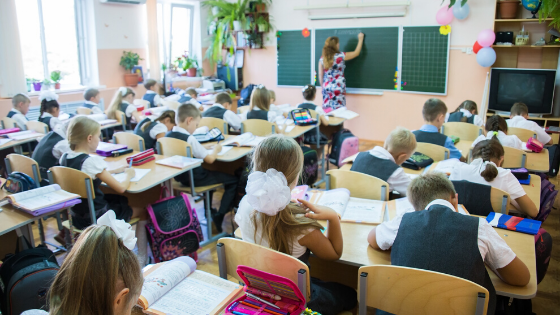
Fundamental to the learning process is the ability of a student to hear and understand what the teacher is saying. But a noisy classroom can stop learning in its tracks, making both hearing and comprehension difficult.
Superfluous noise promotes distraction and disengagement in our children because think about it: If they can’t hear, how can they learn?
The result? Many students are told they may have a learning difficulty when the real problem may be poor classroom acoustics.
Classroom Noise: The Causes
Classroom noise can have many causes. The Acoustical Society of America has identified background classroom noise as any auditory disturbance that interferes with what a listener wants and/or needs to hear. Based on the dozens of inquiries we get every year from schools all over the country, we can categorize background noise sources into three main categories:
- Noise within the classroom or specific space where teaching is taking place – like a multifunction room – caused by voices and/or mechanical noise from air conditioning, heating, ventilation or refrigeration, and more.
- Noise from within the building itself, bleeding into the classroom from hallways, adjacent classrooms, or centralized noise sources. like the public address system.
- Noise from outside the building from traffic, airplanes, playground noise, landscaping noise from lawnmowers and leaf blowers, construction noise, and mechanical noise all heard through the building structure itself.
In addition to background noise, another common issue is poor acoustics.
Poor acoustics can be caused by too much echo or too much reverberation – how sound waves act when they stay in a room. Such sound waves can stay in a classroom and reverberate as they bounce off the hard surfaces of chairs, desks, floors and walls.
Classroom Noise: The Impact
As such, it’s important to keep the classroom as quiet as possible for all children. A quiet classroom helps teachers and students, especially if a student has:
- hearing loss in one or both ears
- an ear infection or fluid in the ear
- a learning disability
- auditory processing disorder
- speech and language delay
- attention problems
Teachers also benefit from good classroom acoustics as talking in a loud classroom strains the teacher’s voice and may lead to voice problems.
And when classroom acoustics are poor, it can cause problems with how every student understands speech, reads and spells, behaves in the classroom, pays attention, and concentrates.
Classroom Noise: Solutions
It’s important to think about background noise and reverberation in any space used for learning. Some simple ways to make a classroom quieter include:
- Placing rugs or carpet in the room
- Hanging curtains or blinds in the windows
- Hanging soft materials, such as felt or corkboard, on the walls
- Placing tables at an angle around the room instead of in rows
- Turning off noisy equipment when it’s not in use
- Replacing noisy light fixtures
- Showing students how hard it can be to hear when many children talk at the same time
- Placing soft tips on the bottom of chairs and tables
For more permanent and effective reductions in reverberation and echoing, the installation of absorbent materials, such as our line of REVRB® acoustical panels, baffles and banners, have proven to be effective solutions to noise problems throughout school campuses, from classrooms, to gymnasiums, to multipurpose rooms.
School Case Studies
See how we've helped a variety of schools solve their specific noise and acoustic issues:
To learn more about classroom noise and acoustics, check out this brochure – The Noisy Classroom – in the American Speech-Language-Hearing Association, or ASHA, bookstore.
Additional resources:




